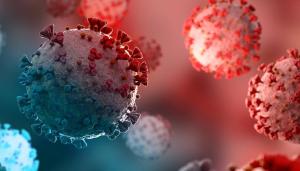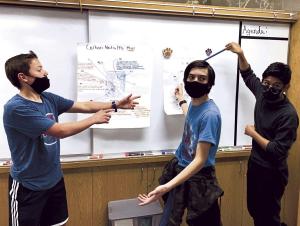LAB REPORT
Science and Technology Making Headlines
March 18, 2022


This Hubble image shows galaxy cluster Abell 1689. It combines both visible and infrared data from Hubble’s Advanced Camera for Surveys (ACS) with a combined exposure time of over 34 hours to reveal this patch of sky in greater and more striking detail than in previous observations. Image credit: NASA, ESA, the Hubble Heritage Team (STScI/AURA), J. Blakeslee (NRC Herzberg Astrophysics Program, Dominion Astrophysical Observatory), and H. Ford (JHU).
Going inside a galaxy cluster
An Earthbound experiment is replicating the extreme heat found in galaxy clusters located in deep space using nearly 200 lasers at the National Ignition Facility.
The hope is the experiment series will reveal more about the conditions within giant groups of galaxies where hydrogen gas can burn at roughly the same temperatures as it does the center of our sun, or roughly 18 million degrees Fahrenheit (10 million degrees Celsius).
Scientists are unsure how these ultrahot conditions can persist within galaxy clusters because the models physicists have built suggest that the gas should have cooled off during the 13.77-billion years the universe has existed.
A team is investigating these conditions with the most energetic laser facility in the world: the National Ignition Facility at Lawrence Livermore. The conditions are created in a dime-sized environment lasting only a fraction of a second, but are a good start to understand more about the galaxy cluster environment, the team says.


Analyzing one of the largest databases of patients with cancer and COVID-19 with machine learning models, researchers from LLNL and the University of California, San Francisco found previously unreported links between a rare type of cancer — as well as two cancer treatment-related drugs — and an increased risk of hospitalization from COVID-19.
Modeling COVID risks and cancer
If a cancer patient tests positive for COVID-19, are they more likely to become hospitalized from the disease?
That depends on certain risk factors, according to a new study by researchers at Lawrence Livermore National Laboratory (LLNL) and the University of California, San Francisco, who looked to identify cancer-related risks for poor outcomes from COVID-19. Analyzing one of the largest databases of patients with cancer and COVID-19, the team found previously unreported links between a rare type of cancer — as well as two cancer treatment-related drugs — and an increased risk of hospitalization from COVID-19.
"There is still a lot of fear of what the impacts are to the risk of patients with cancer and COVID-19," said LLNL principal investigator Priyadip Ray. "The key to this study was the strength of the dataset, which allowed us to look at this niche sector and was big enough to find some statistically significant cancer-related and medicine-related perspectives. These are potentially actionable items for physicians to let their patients be more aware, take more precautions or even look at alternate treatments."


An artist’s depiction of the promise of carbon nanotube porins for desalination. The image depicts a stylized carbon nanotube pipe that delivers clean desalinated water from the ocean to a kitchen tap. Image by Ryan Chen/LLNL.
Worth one’s salt
A carbon nanotube (CNT) is a minuscule, straw-like structure made of carbon atoms. These tubes are extremely useful in a wide variety of electronic, magnetic and mechanical technologies. The diameters of these tubes are so tiny that they are measured in nanometers. A nanometer is one-billionth of a meter — about 10,000 times smaller than a human hair.
Nanotechnology is being applied to the quest to turn seawater into drinking water. In a study, scientists at Lawrence Livermore have developed a carbon nanotube process that can take the salt out of seawater far more efficiently than traditional technologies.
Traditional desalination processes pump in seawater under high pressure, sending it through reverse osmosis membranes. These membranes then reject all large particles, including salts, allowing only clean water to pass through. However, these desalination plants are very expensive and can only process about 10 percent of a county’s water needs, according to LLNL.
In the nanotube study, the scientists mimicked the way biological membranes are structured: essentially a matrix with pores inside the membrane. They used nanotubes that were particularly small — more than 50,000 times thinner than a human hair. These tiny nanotubes allow for a very high flux of water but are so narrow that only one water molecule can pass through the tube at a time. And most importantly, the salt ions are too big to fit through the tube.


Tokay High School students Jason Willes, Angel Guerrero and Bryan Aguilar (from left), explain the carbon neutrality map the created for the Carbon Cleanup Initiative curriculum being taught by science teacher Jennifer Robinson-Buck.
Students go carbon neutral
A select group of Tokay High School students will have the opportunity to showcase their knowledge of climate change at Lawrence Livermore National Laboratory later this year.
Their work includes creating a carbon cleanup map of the San Joaquin Delta and how to convert biomass into something that can be stored underground.
Tokay High School science teacher Jennifer Robinson Buck is one of a handful of educators in California using the Carbon Cleanup Initiative educational toolkit developed by the Livermore Lab Foundation for the spring semester. The curriculum was made available to Buck through a partnership between the foundation and the San Joaquin County Office of Education
Buck said while her students were concerned about climate change, many of them did not know exactly what it was or how it could be solved before she introduced the curriculum this semester.


Colorized illustration from a simulation of a holographic plasma lens. The red concentric circles denote alternating high- and low-density plasma rings. The blue dot at the center represents the focused light. Image by Matthew Edwards/LLNL.
Big energy in small spaces
In the National Ignition Facility (NIF), the world’s highest-energy laser system, a complex series of glass optics — including amplifiers, mirrors, wavelength converters and focusing lenses — strengthens and guides the laser light to its destination. Over the years, researchers have developed and refined these optics so they can withstand the intense energies generated by NIF’s powerful laser beams.
Not even the hardiest solid-state optics, however, can cope with the energies that will be produced by the next generation of ultra-intense, high-repetition-rate lasers now being developed at Lawrence Livermore and elsewhere around the world. Current state-of-the-art 10-petawatt (quadrillion-watt) lasers may soon be eclipsed by 100-petawatt and even exawatt lasers capable of generating 1,000 petawatts of peak power — more than five times the power the Earth receives from sunlight.
To help enable these ultrafast, ultra-high-power lasers, Livermore researchers and their colleagues are exploring ways to build laser optics from plasma — a charged mixture of ions and free electrons — to overcome the limits on maximum fluence (energy density) imposed by conventional solid optics. A plasma optic allows a large amount of energy to be directed into a small space and time in a well-collimated (focused) beam.





